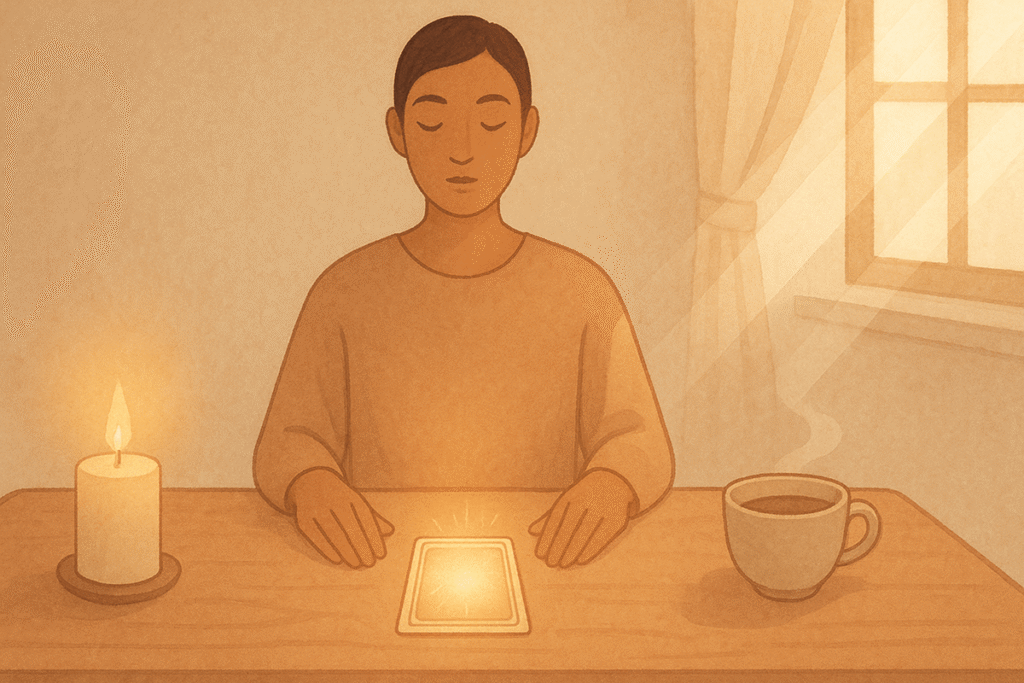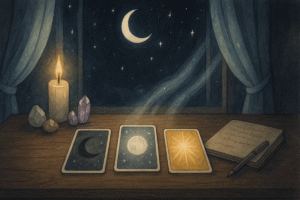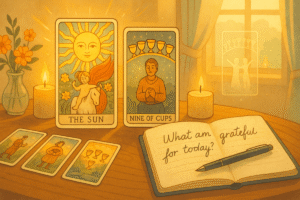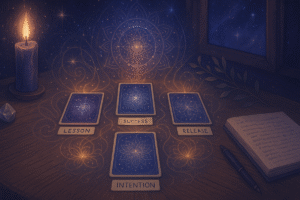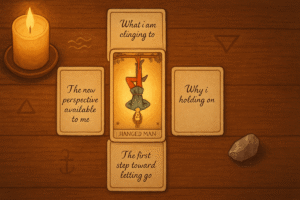Table of Contents
In our constantly moving world, finding moments of genuine stillness feels increasingly challenging. Perhaps you’ve tried various meditation techniques, downloaded mindfulness apps, or attempted breathing exercises, only to find your mind wandering after just a few minutes. What if I told you that a simple tarot card could become your anchor to present-moment awareness?
The practice of using a daily tarot card as a mindfulness tool isn’t about predicting the future or seeking mystical answers. Instead, it transforms these beautifully crafted images into focal points for meditation, reflection, and inner exploration. This approach invites you to slow down, observe without judgment, and connect more deeply with your own thoughts and feelings.
Why Visual Meditation Works
Our brains are naturally wired to process visual information. Think about how easily you can recall a vivid painting or photograph compared to a string of random words. Tarot cards, with their rich symbolism and intricate artwork, provide an ideal visual anchor for meditation practice.
When we focus on a single image during meditation, something interesting happens. The analytical mind, which usually chatters constantly about to-do lists and worries, becomes engaged with the visual details. This engagement creates space for a deeper, more intuitive awareness to emerge. You might notice subtle emotions arising, or find yourself reflecting on patterns in your own life without forcing the process.
I’ve found that visual meditation feels more accessible than traditional breath-focused practices, especially for beginners. There’s something to look at, something tangible to return to when the mind inevitably wanders. The card becomes a gentle teacher, always there to guide your attention back to the present moment.
Setting Up Your Daily Practice
Creating a sustainable daily tarot mindfulness practice requires minimal preparation, but intention matters more than elaborate setups. Choose a quiet space where you won’t be interrupted for at least ten minutes. This doesn’t need to be a dedicated meditation room; a corner of your bedroom or even your kitchen table works perfectly well.
Keep your tarot deck in this space, perhaps wrapped in a soft cloth or stored in a beautiful box. The ritual of unwrapping or opening the box signals to your mind that you’re transitioning into a more contemplative state. Some people prefer to light a candle or play soft instrumental music, while others enjoy complete silence. Experiment to discover what helps you feel most centered.
Timing can be flexible, though many practitioners find morning sessions particularly powerful. There’s something about engaging with an image before the day’s demands take hold that sets a reflective tone for everything that follows. However, evening sessions can be equally valuable, offering a way to process the day’s experiences through the lens of symbolic imagery.
The Five-Minute Focus Technique
Begin by holding your deck in both hands. Close your eyes and take three deep breaths, feeling the weight and texture of the cards. This simple action helps transition your nervous system from its typical alert state into a more receptive mode.
As you shuffle, maintain your focus on breathing naturally. Don’t worry about shuffling techniques or how many times to mix the cards. The goal is simply to stay present with the physical sensations of handling the deck while keeping your breath steady and relaxed. Some days this feels effortless, other days your mind might race with random thoughts. Both experiences are perfectly normal.
When you feel ready, draw a single card and place it in front of you. Now comes the heart of the practice. Set a timer for five minutes and simply observe the card without trying to interpret its meaning or significance. This isn’t about what the card represents in traditional tarot systems; it’s about what you notice in this moment.
What to Observe During Your Session
Start with the most obvious visual elements. What colors dominate the image? Are they warm and inviting, or cool and calming? Perhaps there’s a mixture that creates tension or harmony. Notice how these colors make you feel without judging those feelings as good or bad.
Move your attention to the figures or objects depicted. Are there people in the image? What are they doing? How are they positioned in relation to each other? Sometimes I find myself drawn to tiny details I hadn’t noticed before, like the expression on a character’s face or the way light falls across a particular element.
Symbols and patterns often emerge during extended observation. You might notice geometric shapes, natural elements like water or mountains, or architectural features. Don’t rush to assign meaning to these symbols. Instead, simply acknowledge their presence and observe how they interact with other elements in the composition.
The emotional quality of the image deserves attention too. Does the overall scene feel peaceful, dynamic, mysterious, or celebratory? Sometimes a card that initially appears simple reveals layers of complexity the longer you observe it. Other times, a busy, detailed card might suddenly feel unified and calm.
Working with Thoughts and Feelings
As you observe the card, thoughts and feelings will inevitably arise. This is not a sign that you’re doing something wrong; it’s actually the whole point of the practice. The card serves as a mirror, reflecting back aspects of your inner landscape that might otherwise remain unconscious.
You might find yourself thinking about a current relationship while looking at a card depicting two figures. Or perhaps an image of a solitary traveler evokes feelings about a decision you’re contemplating. The key is to notice these connections without immediately analyzing them or creating stories around them.
When strong emotions arise during the practice, breathe into them rather than pushing them away. The card has simply provided a safe container for feelings that were already present within you. Sometimes this process brings clarity about situations in your life, other times it simply offers a moment of emotional release without any clear resolution.
I think the most surprising aspect of this practice is how differently the same card can affect you on different days. A card that feels empowering on Monday might evoke vulnerability on Thursday. This variability isn’t inconsistency; it’s evidence of your own changing inner weather and the card’s ability to meet you wherever you are.
Beyond the Five Minutes
After your timer sounds, take a moment to sit quietly without looking at the card. Notice any shifts in your mental or emotional state. Do you feel more grounded, more spacious, or perhaps more aware of something that was previously unconscious?
Some practitioners like to journal briefly after their card meditation, capturing insights or feelings that emerged during the session. This isn’t about analyzing the card’s traditional meaning, but rather recording your personal response to the imagery. Over time, these notes can reveal patterns in your own psychological landscape.
Others prefer to carry the memory of the card’s imagery with them throughout the day, occasionally returning to it as an anchor point during stressful or scattered moments. There’s no right way to integrate the practice; the important thing is finding what feels sustainable and meaningful for you.
Common Challenges and Gentle Solutions
Nearly everyone struggles with mental restlessness when beginning visual meditation practices. Your mind might want to immediately interpret the card, remember what you read about its meaning, or skip ahead to tomorrow’s card. When this happens, gently redirect your attention back to simple observation. Think of it like training a puppy; consistent, patient redirection works better than frustration.
Some days you might draw a card that feels irrelevant or uninteresting. This is actually a wonderful opportunity to practice finding depth in the mundane. Often, cards that initially seem boring reveal the most surprising insights when we’re willing to sit with them patiently.
Physical discomfort can also arise during meditation. If sitting still for five minutes feels challenging, try adjusting your position mindfully rather than abandoning the practice. Sometimes the discomfort in our bodies mirrors internal restlessness, and working gently with both can deepen the overall experience.
Building Long-Term Consistency
The benefits of daily tarot mindfulness accumulate gradually, like water slowly wearing smooth stones. Missing a day here and there won’t undermine your progress, but establishing a regular rhythm helps the practice become a natural part of your routine.
Consider linking your card practice to an existing habit, like having your morning coffee or brushing your teeth before bed. This connection makes it easier to remember and creates a sense of ritual around the practice.
Remember that some sessions will feel profound and insightful, while others might seem ordinary or even difficult. Both types of experiences contribute to your growing capacity for present-moment awareness. The goal isn’t to have peak experiences every day, but rather to show up consistently with curiosity and openness.
Perhaps the most beautiful aspect of using tarot cards for mindfulness is how the practice evolves naturally over time. What begins as simple visual observation gradually deepens into a dialogue with your own wisdom, using the card’s imagery as a starting point for increasingly subtle self-awareness. This gentle, reflective approach honors both the ancient tradition of contemplative practice and the modern understanding of mindfulness as a tool for psychological well-being.
Frequently Asked Questions
Do I need to know tarot card meanings to practice this meditation?
Not at all. This practice intentionally sets aside traditional tarot meanings to focus purely on visual observation and personal response. You’re not trying to interpret the card according to any established system; you’re simply noticing what you see and how it makes you feel. In fact, knowing the meanings can sometimes interfere with the raw, unfiltered observation that makes this practice so valuable. Your personal connection to the imagery matters more than any guidebook definition.
How long should I practice before I notice benefits?
Most people report feeling more grounded and present after just their first session. The immediate benefit is simply having five minutes of focused attention in your day. However, the deeper rewards like enhanced self awareness and improved ability to sit with difficult emotions typically emerge after two to three weeks of consistent practice. Think of it like learning any new skill; the basic technique becomes familiar quickly, but the nuanced benefits accumulate gradually over time.
What if I draw the same card repeatedly?
This happens more often than you might think, and it’s actually quite meaningful. Rather than being a coincidence, repeated cards often indicate themes or emotions in your life that need sustained attention. Instead of reshuffling immediately, consider spending extra time with the repeated card across multiple sessions. What new details emerge when you look at it on different days? How does your emotional response shift? Sometimes a card will appear multiple times until you’ve fully processed whatever it’s reflecting back to you.
Can I use oracle cards instead of traditional tarot?
Absolutely. Any deck with rich visual imagery works beautifully for this practice. Oracle cards, with their varied themes and artistic styles, can be just as effective as traditional tarot for visual meditation. Some people actually prefer oracle decks because they feel less bound by established symbolic systems. The key is choosing a deck whose artwork speaks to you and invites deeper looking. Whether it’s tarot, oracle, or even art cards, what matters is the quality of imagery and your willingness to engage with it mindfully.

